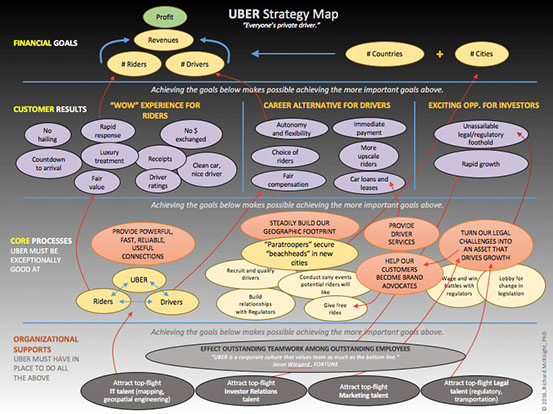

SECTIONS
A Very Simple Enterprise Strategy Map
Example Of A Functional Unit Strategy Map
Example Of An Enterprise Strategy Map
Once You Have a Strategy Map, Then What?
An Introduction to Strategy Mapping
A strategy map is a graphic portrayal of an organization’s strategy showing how various strategic initiatives will lead to customer results and, in turn, to financial results if the organization is for-profit, or mission results if nonprofit.
A strategy map can depict the aims and intentions of an entire corporation or the plans of just one part of a nonprofit organization.
The strategy map concept is not a new tool; it was introduced by Kaplan and Norton (1996) in their book, The Balanced Scorecard: Translating Strategy into Action. In that volume and in each subsequent book devoted to the Balanced Scorecard, Kaplan and Norton have discussed strategy maps. Their book, Strategy Maps: Converting Intangible Assets into Tangible Outcomes (2004), is devoted to the topic. In that book, Kaplan and Norton write, “The strategy map has turned out to be as important an innovation as the original Balanced Scorecard itself.” (Kaplan & Norton, 2004, page xiii). If you do not want to read 450 pages on the topic (Kaplan & Norton), read this tutorial and then Chapter Eight in our book, Leading Strategy Execution.
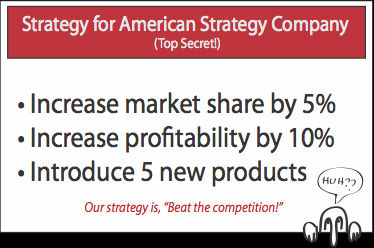
BENEFITS OF A STRATEGY MAP
The process of constructing a strategy map aligns a senior leadership team and permits it to do several things:
• Set vividly clear targets in two areas: financial results and the customer results that will lead to them.
• Trace the causal connections between various elements of the strategy and the results, showing what activity leads to what results.
• Tell a compelling story about the company’s aspirations and how they will be achieved.
• Identify the critical organizational capabilities that will undergird and support the key value-adding business processes—and what those business processes are.
• Provide a starting point for every work unit to identify the actions it must take to support the overall enterprise strategy.
A VERY SIMPLE ENTERPRISE STRATEGY MAP
Below is a very simplified strategy map. It depicts how Southwest Airlines (SWA) creates value. Please note that in our use of the language of strategy maps, we use slightly different wording than do Kaplan and Norton. Most specifically, we use the term “Organizational Capability” rather than their term “Learning and Growth,” because we think it more clearly communicates what this dimension is all about.
SWA’s is a strategy based on low fares, and the means of accomplishing this is by making the most efficient use possible of their aircraft. The term “Fast ground turnaround”—in the Business Processes row—sums up the intention. How to achieve this? Through “World-class teamwork,” in the organizational capabilities row.
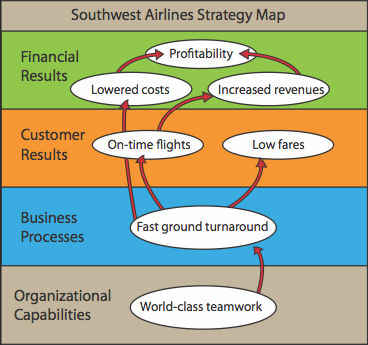
EXAMPLE OF A FUNCTIONAL UNIT STRATEGY MAP
Working from simple to more complex, below is the map we helped the CIO of a medical devices company build for the IT function. Reality: IT exists only to support business lines accomplish their goals. Therefore, in the Customer Results row, IT has represented the principal needs that each business line has of IT, i.e., support in bringing new products to market quickly, and reliable IT service.
In turn, IT’s Business Processes must reflect those customer needs and IT must build processes to deliver that value. These should be spelled out in documentation accompanying the Strategy Map. The bottom row, Organizational Capabilities, calls for strategic activities and initiatives that support delivering value to the customer.
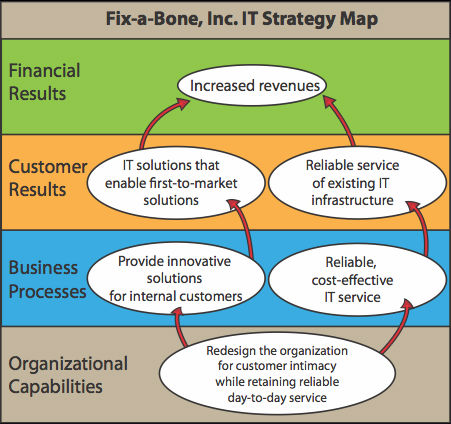
EXAMPLE OF AN ENTERPRISE STRATEGY MAP
You can see from the hard-to-read illustration below why most of our clients commit their enterprise map to a larger piece of paper! In this case, a water filtration and analytical services company has three distinct lines of business. Arguably, each could have its own strategy map, and in fact, each business leader did build their own map. But here, you see the entire portfolio depicted at one go. The “bubbles” that span more than one business line, e.g., “Preferred Vendor/Operator,” in the Customer Results segment, is a customer result that each of the businesses needs to get.
UBER
UBER Technologies, Inc., whose slogan is "Everyone's private driver," has recently (2016) been valued at $54B, making Uber more valuable than the entire U.S. taxi and limousine industry combined, even more than General Motors! UBER is disrupting the ride hailing industry while not owning a single vehicle.
Uber takes 10% of the base fare plus a $1 per ride surcharge from cab drivers, and 20% of the base fare for black cars. The core business model for UBER is that of a two-sided platform connecting riders and drivers. UBER now operates in 311 cities and 58 countries.
We use the UBER business model as a business case and have modeled their strategy via a strategy map, below. If you would like to see this map larger, click here.
VARIATIONS ON A THEME
Pictured below are variations on strategy maps we have created. While they all look different, they convey the same information:
• Financial results sought
• Customer results that must be delivered to get those financial results
• Business processes necessary to create value for customers
• Organizational capabilities required to support the business processes
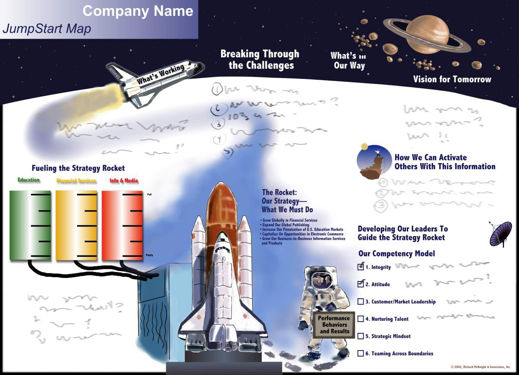
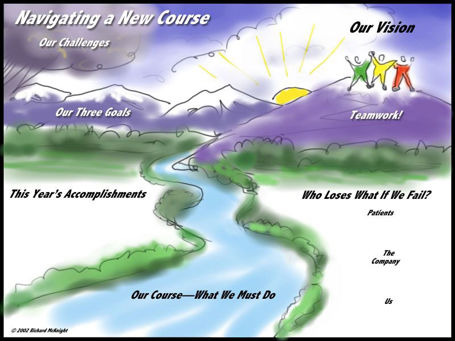
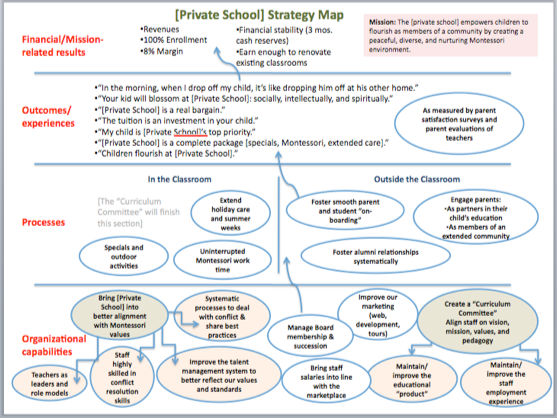
ONCE YOU HAVE A STRATEGY MAP, THEN WHAT?
Constructing a strategy map, as we’ve said, produces many benefits: senior team alignment, clarification of the strategy, ease of communication to employees, and can help generate enthusiasm by employees for the strategy. But in reality, creating a strategy map is just the beginning of the work required for strategy execution. In our book, Leading Strategy Execution, we devote two chapters to what leaders need to do once the strategy map is complete. Chapter Six, “Aligning Local Effort (Job Three),” acknowledges that strategies get carried out in work units, not at the top of the organization, and guide the reader in thinking through how the top can align itself with the middle-level. Chapter Seven, “Designing Your Organization (Job Four),” addresses, “the art and science of fitting the institutional components of the firm—its structure, business processes, and its entire social system—to the strategy.”
We view strategy execution as a three step process:
Step 1
Create the strategy map
Step 2
Design the organization
Step 3
Deploy the strategy, engage the workforce
Put simply, once you have a strategy map, the intentions captured in the bottom two tiers of the strategy map must be articulated in the form of specific objectives, metrics attached, and both due dates and accountabilities assigned.
Does all of this seem like hard work? It is! In our view, “Two D’s” separate market leaders from everyone else: Discipline—doing the work above—and Diligence, which means doing so relentlessly. Think of any winning sports team or business you admire: did they get where they are without discipline and diligence? We don’t think so, either.
TO LEARN MORE
Get our book, Leading Strategy Execution
Get the first three Chapters of LSE FREE
Read Kaplan and Norton’s book, Strategy Maps
Learn about how we use strategy maps in aligning senior teams

You cannot map an inadequate strategy—like this one—which is why we like the strategy mapping tool. Strategy mapping forces strategy discipline, telling the story of what causes what.
In this slide, note that two irreconcilable interpretations are possible: Increasing market share causes and results from introducing new products.
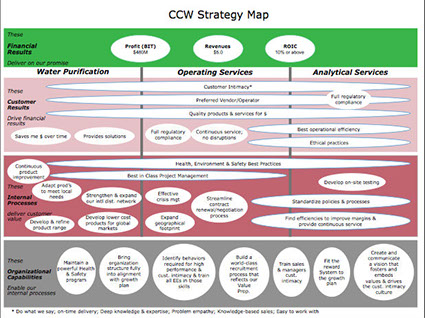
We developed this map with the senior team of an international publishing company. The team was intrigued with space flight as a metaphor for their strategy.
The “squiggly” lines on the map simulate the writing participants did on the map itself, a 3’x4’ laminated document.
Participants wrote in the blank spaces on the map, a 3’x4’ laminated document. Dozens of these maps hung for months in work areas in the plants.
This case is described in Chapter Eight of our book, Leading Strategy Execution.
We created this map with and for the Board and senior leaders of a prominent private school in the Philadelphia area.
The final deliverable included a 20-page narrative explaining the map and a strategy execution plan.
We are now working with the Director and senior leaders to execute the plan.
Read definitions of Financial Results and Customer Results
Read definitions of Business Processes and Organizational Capabilities
